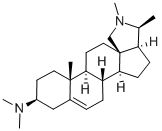Dioctylamine
- CAS NO.:1120-48-5
- Empirical Formula: C16H35N
- Molecular Weight: 241.46
- MDL number: MFCD00009557
- EINECS: 214-311-6
- SAFETY DATA SHEET (SDS)
- Update Date: 2024-12-18 14:15:30

What is Dioctylamine?
Chemical properties
colourless to light yellow liquid
The Uses of Dioctylamine
Dioctylamine can be used as a reactant in the synthesis of:
- Ionic liquids based on the tetra-alkyl-dimethylguanidinium cation
- N-(2,5-di-tert-butylphenyl)perylene-3,4-dicarboximide based perylene photosensitizers.
It can be also employed as a surfactant in the shape-controlled synthesis of some nanoparticles.
The Uses of Dioctylamine
Di-n-octylamine can be used as intermediate for the preparation of antistatic agent, softener, surfactant and it is also used as metal extraction agent and amine solvent. In addition, it can be used to get octanal.
Definition
ChEBI: Dioctylamine is a secondary amine in which the two alkyl substituents are specified as octyl.
Synthesis Reference(s)
The Journal of Organic Chemistry, 60, p. 8120, 1995 DOI: 10.1021/jo00130a002
Properties of Dioctylamine
| Melting point: | 13-16 °C (lit.) |
| Boiling point: | 297-298 °C (lit.) |
| Density | 0.799 g/mL at 25 °C (lit.) |
| vapor density | 8.3 (vs air) |
| vapor pressure | 0.01 mm Hg ( 20 °C) |
| refractive index | n |
| Flash point: | >230 °F |
| storage temp. | 2-8°C(protect from light) |
| form | Liquid |
| pka | 11.10±0.19(Predicted) |
| Specific Gravity | 0.799 |
| color | Clear colorless to light yellow |
| Water Solubility | immiscible |
| BRN | 1748376 |
| Stability: | Stable. Combustible. Incompatible with strong oxidizing agents, acids. |
| CAS DataBase Reference | 1120-48-5(CAS DataBase Reference) |
| NIST Chemistry Reference | 1-Octanamine, n-octyl-(1120-48-5) |
| EPA Substance Registry System | 1-Octanamine, N-octyl- (1120-48-5) |
Safety information for Dioctylamine
| Signal word | Danger |
| Pictogram(s) |
 Corrosion Corrosives GHS05  Exclamation Mark Irritant GHS07  Environment GHS09 |
| GHS Hazard Statements |
H302:Acute toxicity,oral H314:Skin corrosion/irritation H410:Hazardous to the aquatic environment, long-term hazard |
| Precautionary Statement Codes |
P270:Do not eat, drink or smoke when using this product. P273:Avoid release to the environment. P280:Wear protective gloves/protective clothing/eye protection/face protection. P301+P312:IF SWALLOWED: call a POISON CENTER or doctor/physician IF you feel unwell. P303+P361+P353:IF ON SKIN (or hair): Remove/Take off Immediately all contaminated clothing. Rinse SKIN with water/shower. P305+P351+P338:IF IN EYES: Rinse cautiously with water for several minutes. Remove contact lenses, if present and easy to do. Continuerinsing. |
Computed Descriptors for Dioctylamine
New Products
4-Fluorophenylacetic acid 4-Methylphenylacetic acid N-Boc-D-alaninol N-BOC-D/L-ALANINOL Tert-butyl bis(2-chloroethyl)carbamate 3-Morpholino-1-(4-nitrophenyl)-5,6-dihydropyridin- 2(1H)-one Furan-2,5-Dicarboxylic Acid Tropic acid S-2-CHLORO PROPIONIC ACID ETHYL ISOCYANOACETATE 2-Bromo-1,3-Bis(Dimethylamino)Trimethinium Hexafluorophosphate (6-METHYL-[1,3]DITHIOLO[4,5-b]QUINOXALIN-2-ONE INDAZOLE-3-CARBOXYLIC ACID 4-IODO BENZOIC ACID (2-Hydroxyphenyl)acetonitrile 4-Bromopyrazole 5,6-Dimethoxyindanone 2-(Cyanocyclohexyl)acetic acid 4-methoxy-3,5-dinitropyridine 2-aminopropyl benzoate hydrochloride 1-(4-(aminomethyl)benzyl)urea hydrochloride diethyl 2-(2-((tertbutoxycarbonyl)amino) ethyl)malonate tert-butyl 4- (ureidomethyl)benzylcarbamate Ethyl-2-chloro((4-methoxyphenyl)hydrazono)acetateRelated products of tetrahydrofuran








You may like
-
 Dioctylamine 98% CAS 1120-48-5View Details
Dioctylamine 98% CAS 1120-48-5View Details
1120-48-5 -
 Di-n-octylamine CAS 1120-48-5View Details
Di-n-octylamine CAS 1120-48-5View Details
1120-48-5 -
 Di-n-octylamine CAS 1120-48-5View Details
Di-n-octylamine CAS 1120-48-5View Details
1120-48-5 -
 Di-n-octylamine CAS 1120-48-5View Details
Di-n-octylamine CAS 1120-48-5View Details
1120-48-5 -
 Dioctylamine, 98% CAS 1120-48-5View Details
Dioctylamine, 98% CAS 1120-48-5View Details
1120-48-5 -
 Dioctylamine CAS 1120-48-5View Details
Dioctylamine CAS 1120-48-5View Details
1120-48-5 -
 14714-50-2 (2-Hydroxyphenyl)acetonitrile 98+View Details
14714-50-2 (2-Hydroxyphenyl)acetonitrile 98+View Details
14714-50-2 -
 118753-70-1 98+View Details
118753-70-1 98+View Details
118753-70-1
Statement: All products displayed on this website are only used for non medical purposes such as industrial applications or scientific research, and cannot be used for clinical diagnosis or treatment of humans or animals. They are not medicinal or edible.